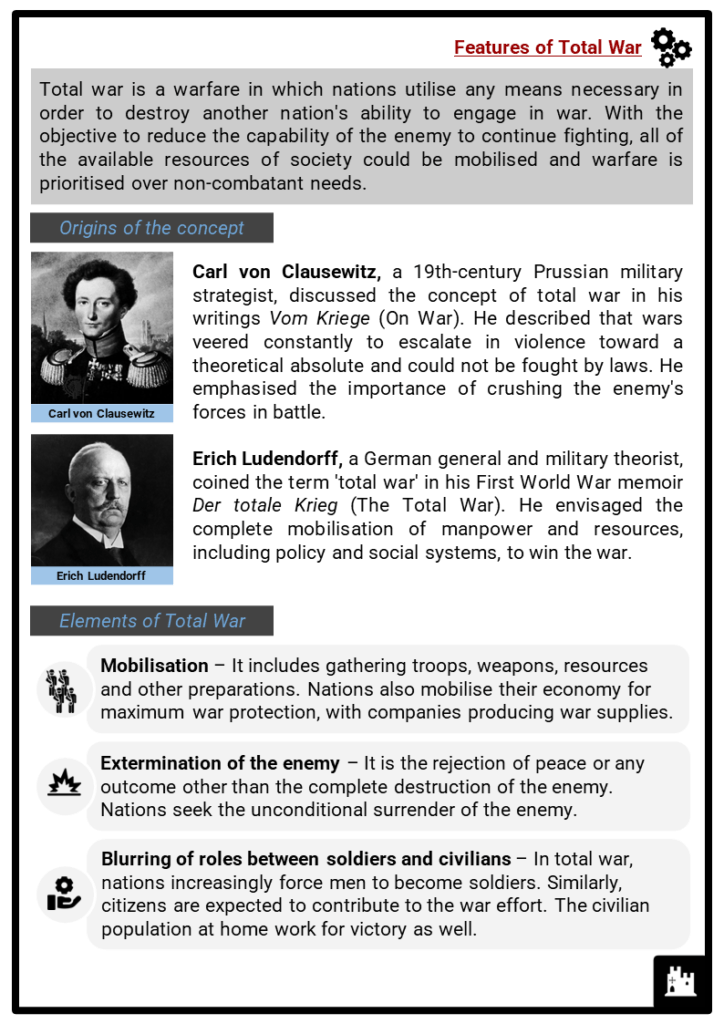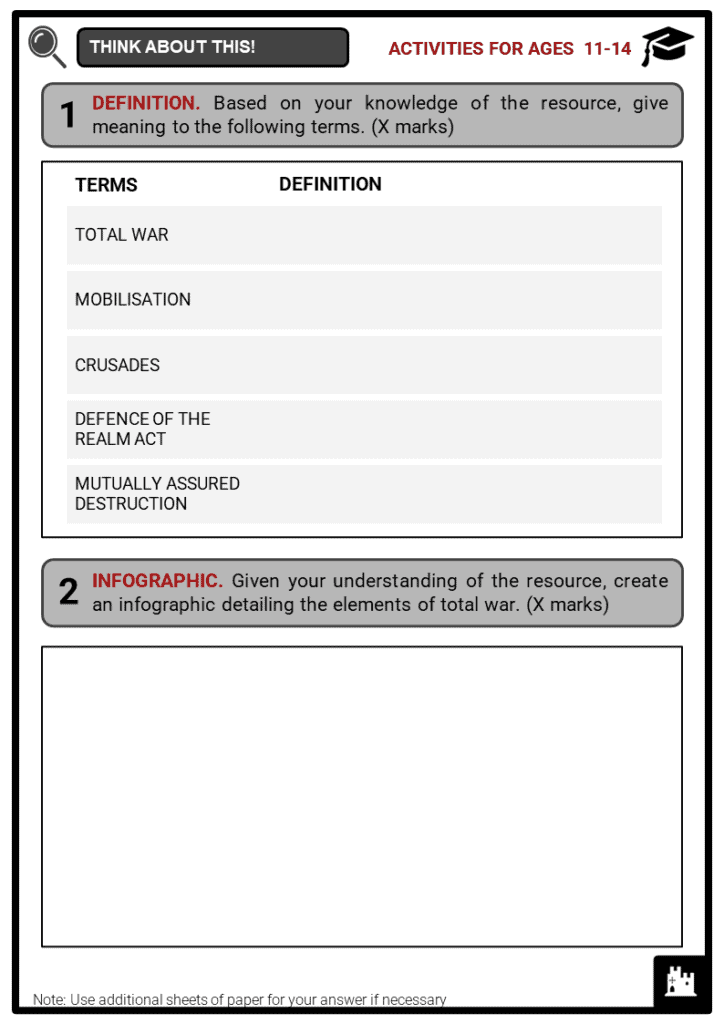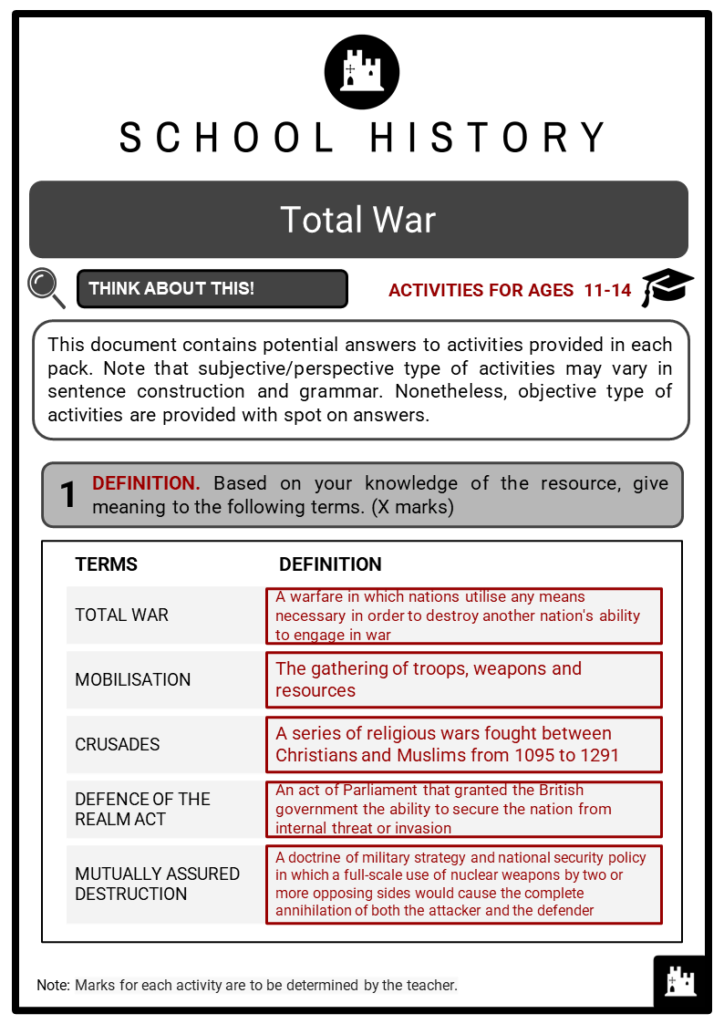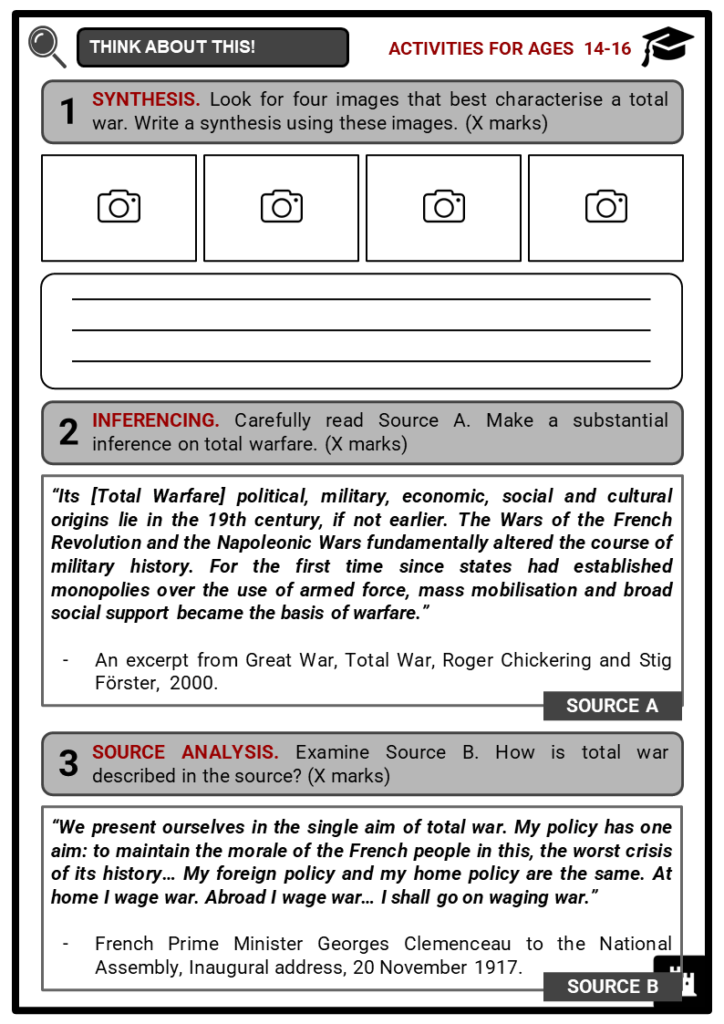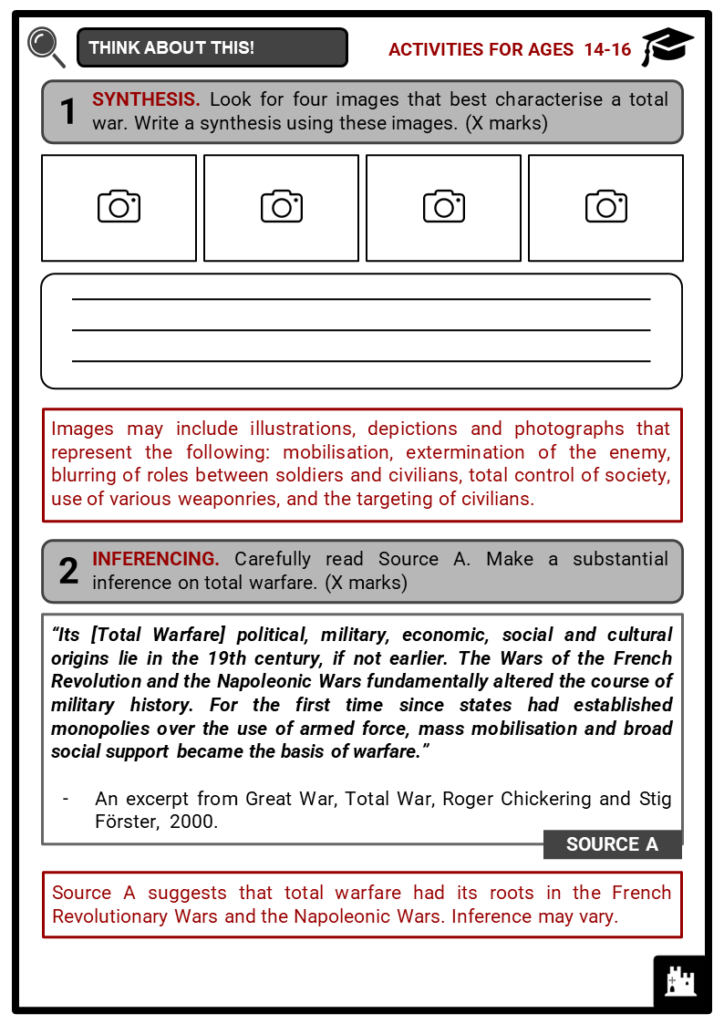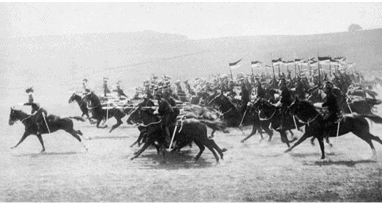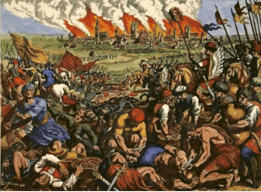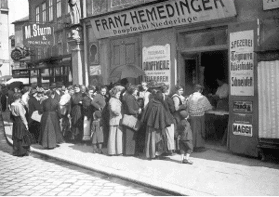Download Total War Worksheets
Do you want to save dozens of hours in time? Get your evenings and weekends back? Be able to teach Total War to your students?
Our worksheet bundle includes a fact file and printable worksheets and student activities. Perfect for both the classroom and homeschooling!
Table of Contents
Add a header to begin generating the table of contents
Summary
- Features of total war
- Early examples of total war
- The World Wars
Key Facts And Information
Let’s know more about Total War!
- Total war calls for the complete involvement of governments, economies and populations of participating nations. Although its concept was first introduced in the 19th and 20th centuries, it had been observed in early conflicts. Elements of total war include mobilisation, extermination of the enemy, blurring of roles between soldiers and civilians, total control of society, use of various weaponries, and the targeting of civilians. The two World Wars of the 20th century are usually regarded as the most total of history's wars.
- The possibility of total devastation that could result from the usage of new weapons and the adoption of the International Humanitarian Law restrain nations in participating in total war scenarios.
Features of Total War
- Total war is a warfare in which nations utilise any means necessary in order to destroy another nation's ability to engage in war. With the objective to reduce the capability of the enemy to continue fighting, all of the available resources of society could be mobilised and warfare is prioritised over non-combatant needs.
- Origins of the concept
- Carl von Clausewitz, a 19th-century Prussian military strategist, discussed the concept of total war in his writings Vom Kriege (On War). He described that wars veered constantly to escalate in violence toward a theoretical absolute and could not be fought by laws. He emphasised the importance of crushing the enemy's forces in battle.
- Erich Ludendorff, a German general and military theorist, coined the term 'total war' in his First World War memoir Der totale Krieg (The Total War). He envisaged the complete mobilisation of manpower and resources, including policy and social systems, to win the war.
- Elements of Total War
- Mobilisation – It includes gathering troops, weapons, resources and other preparations. Nations also mobilise their economy for maximum war protection, with companies producing war supplies.
- Extermination of the enemy – It is the rejection of peace or any outcome other than the complete destruction of the enemy. Nations seek the unconditional surrender of the enemy.
- Blurring of roles between soldiers and civilians – In total war, nations increasingly force men to become soldiers. Similarly, citizens are expected to contribute to the war effort. The civilian population at home work for victory as well.
- Total control of society – All areas of society are impacted. Governments are more involved in civilians' personal lives and even resort to the use of censorship and propaganda to boost or maintain morale.
- Use of various weaponries – Types of weapons used by nations can include biological, chemical, nuclear and other weapons of mass destruction. Nations are willing to use any means necessary to win.
- Targeting of civilians – All citizens of enemy countries are considered legitimate targets. Major infrastructure and essential resources can be targeted too.
- In practice, total war involves and impacts the governments, economies and populations of participating nations.
Early examples of Total War
- Although the term was not used until the 20th century, it is believed that total war had been practised for a long time. The characteristics of total war had been observed in military conflicts before the terminology was conceived.
- Some of the early examples of total war were:
- Peloponnesian War (431-404 BCE): It was fought between the two most powerful city-states in Ancient Greece, Athens and Sparta. In this war, Greek warfare evolved from an originally limited form of conflict to all-out struggles between city-states, with large-scale atrocities.
- Third Punic War (149-146 BCE): It was the third and last of three wars fought between the Roman Republic and the Carthaginian Empire that resulted in the final destruction of Carthage, the enslavement of its population, and Roman hegemony over the western Mediterranean.
- Crusades (1095-1291): These were a series of religious wars between Christians and Muslims which started primarily to secure control of holy sites considered sacred by both groups. Countless villages were burnt and the population of entire cities was slain.
- The Mongol Invasions under Genghis Khan (1220s-1240s): Genghis Khan founded the Mongol Empire by destroying great cities, and slaughtering large portions of their populations. Many citizens were enslaved to be used as human shields in later battles.
-
- Thirty Years' War (1618-1648): It was fought primarily in Central Europe, starting as a battle among the Catholic and Protestant states that formed the Holy Roman Empire. It resulted in the further division of Germany, the end of the wars of religion, and the beginning of the rise of France as a dominant European power.
- French Revolutionary Wars (1792-1802): These were a series of sweeping military conflicts between France and one or more European powers that resulted from the French Revolution. During the Reign of Terror, a series of massacres and numerous public executions took place.
- American Civil War (1861-1865): A civil war in the United States fought between northern and Pacific states and southern states after decades of simmering tensions over slavery, states’ rights and westward expansion. During Sherman’s March to the Sea, smaller towns were burnt and destroyed.
The World Wars
- Distinct from how wars had previously been fought, the two World Wars of the 20th century are usually considered the most total of history's wars. Several elements of total war could be identified in these military conflicts.
- First World War
- The First World War was a global war originating in Europe that lasted from 28 July 1914 to 11 November 1918.
- It was fought between the Central Powers, mainly Germany, Austria-Hungary and Turkey, and the Allies, mainly France, Great Britain, Russia, Italy, Japan and, from 1917, the United States.
- Participating nations mobilised their own civilians for the war effort through forced conscription, military propaganda and rationing.
- Legislations that would be intolerable during peacetime were passed by governments, who acted as interventionists.
- Economic production, nationalising factories, determining production targets, allocating manpower and resources was done by ministers and their departments.
- Military forces and resources like ships, trains or vehicles were commandeered for military purposes and achieved through conscription.
- Governments formed during the war acted to protect national security by implementing press censorship and curfews.
- Large prison sentences and fines were imposed on anyone not adhering to these laws.
- Morale and money were raised through war bonds and extensive propaganda.
- In Britain, the Defence of the Realm Act passed by Parliament granted the government the ability to secure the nation from internal threat or invasion by handing it wide-ranging powers.
- Among these powers were censorship, the authority to imprison without trial, and the power to court-martial and execute civilians. It also included control of the press and communication media.
- More restrictions were enacted, such as the introduction of daylight saving to give more working hours in the day, and the restriction on alcohol consumption.
- In addition, the British government formed departments to coordinate other areas of the economy such as food, labour and maritime transport.
- Food security was a high priority for both civilians and the military. Any unused land, including parks, commons and disused blocks, was seized by Westminster and used for farming.
- Food rationing was introduced and enforced through food queues. Food was so valuable that it became an offence to feed bread to animals or to throw rice at weddings.
- In Germany, an allied naval blockade caused food shortages.
- The Kriegsrohstoffabteilung, or the War Raw Materials Department, which controlled the distribution of essential war materials, was able to continue industrial production under Walter Rathenau.
- However, after two years of intensive war, resources were heavily depleted and production levels were plummeting.
- A series of reforms to double production of military needs was implemented.
- The Supreme War Office or Oberster Kriegsamt was formed to control and coordinate all aspects of wartime production, including labour and transport.
- The government became empowered by the Auxiliary Service Law and was now able to employ and relocate any adult males it needed to provide labour.
- The agricultural sector took a blow as more than two million men were forced to work in weapons and munitions production, but this had the desired military outcome.
-
- Food and consumer goods became scarce, and together with the ongoing Allied blockade, led to critical food shortages by the winter of 1916.
- In France, the national economy was also mobilised to meet the nation’s war needs.
- This was achieved with less government involvement than in Germany and Britain.
- Weapons needed by France’s military were produced largely by privately owned companies, each specialising in a particular military necessity.
- There were fifteen companies tasked with producing shells while three companies produced rifles.
- These companies were issued with government orders and targets and would work together to achieve those targets.
- The French achieved some impressive increases in armaments and became the largest Allied producer of weapons and munitions, surpassing the record set by the United States.
- However, workers suffered socially, and with stagnant wages and rising prices.
- Second World War
- The Second World War was a conflict involving virtually every part of the world that lasted from 1939 to 1945.
- It was fought between the Axis powers – Germany, Italy and Japan – and the Allies – France, Great Britain, the United States, the Soviet Union, and, to a lesser extent, China.
- It was considered a continuation of the disputes left unsettled by the First World War.
- Much like the previous World War, both the Allies and the Axis powers utilised conscription and civilian mobilisation on all fronts.
- Civilians were expected to work longer hours and propaganda continued.
- German citizens were targeted by the Allies to rush the end of the conflict.
- The German city of Dresden, one of Germany's industrial capitals, was firebombed by the British and American forces, destroying the nation's railways system, aircraft factories and other resources.
- In Britain, legislation which allowed immediate mobilisation of the economy had been prepared before the onset of the Second World War.
- Rationing of goods and services was introduced for both consumers and manufacturers.
- All artificial light was subject to legal blackouts. Men and women were conscripted into the armed forces.
- Women were recruited as Land Girls to aid farmers and men as Bevin Boys to work down in the coal mines.
- During the Dunkirk evacuation, a hastily assembled fleet of about seven hundred boats included a mixture of merchant marine boats, fishing boats, pleasure craft, and lifeboats, whose civilian crews were called into service for the emergency.
- As bombing raids were predicted to result in huge casualties, children were evacuated from the cities en masse to the countryside.
- In Germany, women were not conscripted into the armed forces or other services and remained at home.
- Through most of the war, the German economy was under-mobilised.
- The nationalisation of war production and increase in armament production were effected only in the middle of the war.
- Unlike Britain, the United States was not at risk of a major attack.
- However, following the surprise attack on Pearl Harbor, all the nation's resources were utilised to defeat Germany and Japan.
- Rationing was introduced, most non-essential activities were prohibited, and young men were conscripted.
- When the Soviet Union was invaded, the US provided aid by sending American ships to defend aid convoys to the Allied nations against submarine attacks.
- Furthermore, a total trade embargo against Japan was imposed to undermine the offensive actions of its military forces.
- Propaganda efforts began, and many factories retooled for war productions.
- Previously untouched sections and the scientific communities of the nation were mobilised for the war effort.
- When the Second World War came to a close, the practice of total war ended as nuclear warfare was developed in the mid-20th century.
- Nuclear warfare could result in a mutually assured destruction (MAD).
- This caused a change in thinking due to fears of total devastation.
- The International Humanitarian Law, which was adopted following the Geneva Conventions of 1949, outlawed any weapons that were indiscriminate and the deliberate targeting of civilians, but failed to end the use of certain military strategies.
- Major powers hold back in waging wars themselves. As smaller powers engaged in limited wars after the Second World War, the suffering of participating nations and the threat of widespread violence remained.
Image sources:


